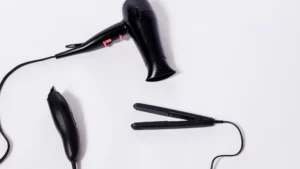Hair loss is a common concern that affects millions of individuals worldwide, transcending age, gender, and ethnicity. Unfortunately, for many individuals, the experience of hair loss, or alopecia, can be distressing and challenging to navigate.
My name is Emma Wright, your resident hair loss and restoration specialist. Today I’ll be discussing the types of hair loss and alopecia.
Alopecia isn’t a one-size-fits-all condition; it manifests in various forms, each with its own triggers, patterns, and treatments. This is why it is important you know the different types of hair loss and causes of hair loss.
Whether it’s a subtle thinning of the hair or more noticeable bald patches, the impact of hair loss extends beyond physical appearance, often affecting self-esteem and emotional well-being. Understanding the underlying causes and available treatment options is crucial for those grappling with this condition.
Hair loss, also known as alopecia, manifests in various forms and can result from a multitude of factors, including genetics, hormonal imbalances, medical conditions, medications, and lifestyle choices.
In this comprehensive guide, we’ll delve into the diverse types of hair loss, shedding light on the intricacies of alopecia and offering insights into understanding and managing this condition.
What is Alopecia?
Alopecia, derived from the Greek word “alopex,” meaning “fox,” is a term encompassing various types of hair loss. Contrary to popular belief, it’s not solely a cosmetic issue but can significantly impact one’s emotional well-being and quality of life.
Understanding the different types of alopecia is crucial for accurate diagnosis and effective management.
5 Types of Hair Loss
1. Androgenetic Alopecia (Male and Female Pattern Baldness)
Androgenetic alopecia, often referred to as female or male pattern baldness, is the most common form of hair loss. It’s characterized by a progressive reduction in hair volume, typically following a distinct pattern.
In men, it manifests as a receding hairline and thinning at the crown, while in women, it often leads to diffuse thinning across the scalp. Androgenetic alopecia is influenced by genetic predisposition and hormonal factors, specifically the hormone dihydrotestosterone (DHT), which miniaturizes hair follicles, leading to their gradual shrinkage and eventual cessation of hair growth.
2. Alopecia Areata
Alopecia areata is an autoimmune disorder characterized by sudden, patchy hair loss. It occurs when the immune system mistakenly targets hair follicles, causing them to enter a dormant phase prematurely.
This results in round or oval-shaped bald patches on the scalp, which can vary in size and number. While the exact cause of alopecia areata remains unclear, it’s believed to involve a combination of genetic, environmental, and immunological factors.
Additionally, stress and traumatic life events are thought to trigger or exacerbate episodes of hair loss in susceptible individuals.
3. Telogen Effluvium
Telogen effluvium is a form of temporary hair loss that occurs when a significant number of hair follicles prematurely enter the telogen (resting) phase of the hair growth cycle. This can be triggered by various factors, including physical or emotional stress, hormonal changes (such as childbirth or thyroid disorders), nutritional deficiencies, certain medications, and chronic illnesses.
Unlike other types of alopecia, telogen effluvium typically manifests as diffuse shedding rather than distinct bald patches. The good news is that hair growth usually resumes once the underlying trigger is addressed or removed.
4. Traction Alopecia
Traction alopecia results from prolonged or excessive tension placed on the hair follicles, often due to tight hairstyles such as braids, ponytails, or extensions.
Over time, this constant pulling can damage the hair follicles and lead to hair breakage and loss, particularly along the hairline and in areas subjected to repeated pulling. Traction alopecia is preventable with proper hair care practices and avoiding hairstyles that place undue stress on the scalp.
However, if left untreated, it can cause permanent hair loss.
5. Cicatricial Alopecia (Scarring Alopecia)
Cicatricial alopecia, also known as scarring alopecia, refers to a group of rare hair loss disorders characterized by inflammation and destruction of hair follicles, leading to irreversible scarring.
Unlike other forms of alopecia, where the hair follicles remain intact, cicatricial alopecia results in permanent hair loss due to the replacement of follicles with scar tissue. The exact cause of cicatricial alopecia varies depending on the subtype, which includes conditions such as lichen planopilaris, frontal fibrosing alopecia, and central centrifugal cicatricial alopecia.
Treatment typically focuses on halting the progression of the disease and managing symptoms to prevent further hair loss.
What is Hair Loss?
Hair loss, also known as alopecia, is a condition characterized by the partial or complete loss of hair from areas where it normally grows. It can occur on the scalp or other parts of the body, and it can vary in severity from mild thinning to significant baldness.
Additionally, hair loss can affect individuals of all ages, genders, and ethnicities and may have various underlying causes.
Hair loss occurs when the hair follicles, the tiny structures in the skin responsible for producing hair, undergo a disruption in their growth cycle or are damaged in some way.
The hair growth cycle consists of three main phases:
- Anagen Phase: This is the active growth phase during which hair follicles produce new hair. The duration of the anagen phase varies depending on factors such as genetics and age.
- Catagen Phase: This transitional phase marks the end of the active growth phase. The hair follicle shrinks and detaches from the dermal papilla, leading to the cessation of hair growth.
- Telogen Phase: In this resting phase, the hair follicle remains dormant, and the hair shaft is eventually shed from the scalp. It is normal to shed a certain amount of hair during the telogen phase, typically between 50 to 100 hairs per day.
Hair loss occurs when there is a disruption in this natural growth cycle. This disruption can be caused by a variety of factors, including:
- Genetics: Androgenetic alopecia, also known as male or female pattern baldness, is the most common type of hair loss and is often hereditary.
- Hormonal changes: Hormonal fluctuations, such as those that occur during puberty, pregnancy, childbirth, and menopause, can contribute to hair loss.
- Medical conditions: Certain medical conditions, such as thyroid disorders, autoimmune diseases, and scalp infections, can cause hair loss.
- Medications: Some medications, including chemotherapy drugs, blood thinners, and antidepressants, can cause hair loss as a side effect.
- Physical or emotional stress: Physical trauma, such as surgery, illness, or significant weight loss, as well as emotional stressors, can trigger temporary hair loss known as telogen effluvium.
- Hairstyling practices: Excessive heat styling, chemical treatments, and tight hairstyles that pull on the hair can lead to hair breakage and traction alopecia.
- Nutritional deficiencies: Inadequate intake of essential nutrients, such as iron, protein, and vitamins, can affect the health of the hair and contribute to hair loss.
The specific type and pattern of hair loss can vary depending on the underlying cause. While some forms of hair loss, such as androgenetic alopecia, may be permanent, others, such as telogen effluvium, may be temporary and resolve once the underlying cause is addressed.
Treatment options for hair loss depend on the underlying cause and may include medications, topical treatments, hair transplant surgery, and lifestyle modifications. Consulting with a dermatologist or healthcare professional is recommended for accurate diagnosis and personalized treatment recommendations.
Types of Hair Loss In Women
Hair loss in women can be distressing and can have a significant impact on self-esteem and quality of life. While many people associate hair loss primarily with men, it is also a common concern for women.
Understanding the different types of hair loss that affect women is essential for accurate diagnosis and effective treatment.
Here are some of the most common types of hair loss in women:
- Androgenetic Alopecia (Female Pattern Hair Loss)
- Telogen Effluvium
- Alopecia Areata
- Traction Alopecia
- Cicatricial Alopecia (Scarring Alopecia)
Treatment options for hair loss in women vary depending on the underlying cause and may include medications, topical treatments, hair transplant surgery, and lifestyle modifications. Consulting with a dermatologist or healthcare professional is recommended for accurate diagnosis and personalized treatment recommendations tailored to individual needs.
Types of Hair Loss In Men
Hair loss is a common concern for men, affecting a significant portion of the male population at some point in their lives. Understanding the different types of hair loss that affect men is crucial for accurate diagnosis and effective treatment.
Here are some of the most common types of hair loss in men:
- Androgenetic Alopecia (Male Pattern Baldness)
- Alopecia Areata
- Telogen Effluvium
- Traction Alopecia
- Cicatricial Alopecia (Scarring Alopecia)
Treatment options for hair loss in men vary depending on the underlying cause and may include medications, topical treatments, hair transplant surgery, and lifestyle modifications. Consulting with a dermatologist or healthcare professional is recommended for accurate diagnosis and personalized treatment recommendations tailored to individual needs.
Hair Loss Treatment
Hair loss treatment varies depending on the underlying cause and the severity of the condition. Here are some common treatment options for hair loss:
Medications
- Minoxidil:Minoxidil, available as a topical solution or foam, is one of the most common treatments for male and female pattern baldness. It works by widening blood vessels, increasing blood flow to the hair follicles, and stimulating hair growth. Minoxidil is applied directly to the scalp once or twice daily.
- Finasteride:Finasteride is an oral medication approved for the treatment of male pattern baldness. It works by inhibiting the enzyme 5-alpha reductase, which converts testosterone to dihydrotestosterone (DHT), the hormone responsible for shrinking hair follicles. Finasteride is typically taken once daily and may take several months to see results. It is not recommended for use in women.
Topical Treatments
- Corticosteroids: Topical corticosteroids are often prescribed to treat alopecia areata. They work by reducing inflammation and suppressing the immune system’s attack on the hair follicles. Corticosteroids may be applied as a cream, ointment, or solution directly to the affected areas of the scalp.
- Anthralin: Anthralin is a topical medication used to treat alopecia areata and psoriasis. It works by slowing down the growth of skin cells and reducing inflammation. Anthralin is typically applied to the scalp and left on for a short period before being washed off.
Hair Transplant Surgery
Hair transplant surgery involves transplanting hair follicles from a donor site (usually the back or sides of the scalp) to the balding or thinning areas. There are two main types of hair transplant procedures: follicular unit transplantation (FUT) and follicular unit extraction (FUE). Hair transplant surgery can provide long-lasting results and a natural-looking appearance, but it may require multiple sessions and can be expensive.
Platelet-Rich Plasma (PRP) Therapy
PRP therapy involves injecting a concentrated solution of platelets from the patient’s own blood into the scalp. Platelets contain growth factors that promote hair growth and regeneration. PRP therapy is often used as a treatment for androgenetic alopecia and may be combined with other hair loss treatments for enhanced results.
Lifestyle Modifications
Maintaining a healthy lifestyle can help promote hair health and reduce the risk of hair loss. This includes eating a balanced diet rich in vitamins and minerals, managing stress levels, avoiding harsh hair treatments and hairstyles that pull on the hair, and practicing good hair care habits.
It’s essential to consult with a dermatologist or healthcare professional before starting any hair loss treatment to determine the most appropriate approach based on the underlying cause of hair loss and individual needs. Treatment outcomes can vary, and some treatments may take several months to show results, so patience and consistency are key.
Conclusion
Hair loss is a multifaceted issue that can have profound psychological and emotional ramifications. By understanding the different types of alopecia, individuals can better comprehend their condition and explore appropriate treatment options.
Whether it’s androgenetic alopecia, alopecia areata, telogen effluvium, traction alopecia, or cicatricial alopecia, seeking professional guidance from dermatologists or trichologists is essential for accurate diagnosis and personalized management strategies.
While alopecia may present challenges, it’s important to remember that there are effective treatments available, and support networks exist to help individuals navigate their journey toward hair restoration and self-confidence.














